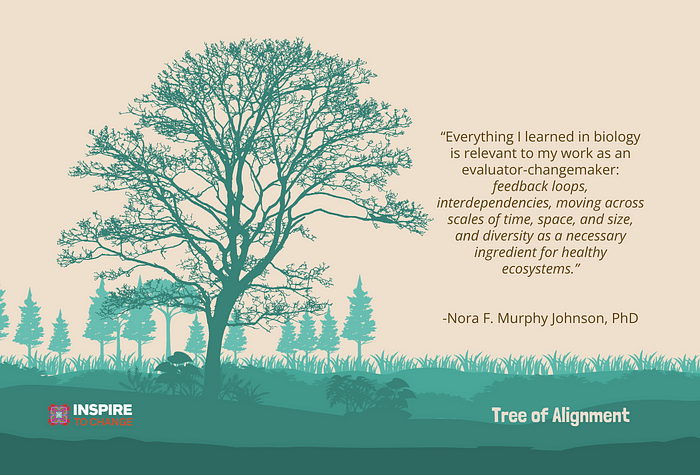
In the quest for transformative change, whether in organizations, communities, or individual lives, understanding the dynamics and drivers of change is critical. The “Tree of Alignment,” a metaphorical concept, provides a comprehensive framework for fostering environments that are conducive to meaningful and lasting change.
Most of you know me as an evaluator, researcher, or changemaker. But my first love was biology. I couldn’t get enough of my classes on plant biology and comparative physiology. I dabbled in marine biology and tropical ecology, doing site work in Tobago, Costa Rica, Belize, and the US Virgin Islands. I later spent a semester studying the desert ecology of the Southwestern United States. I taught high school biology for a few years and ran environmental service programs for the Student Conservation Association. I didn’t make the jump to research and evaluation until I was in my late 20s, and it was years after that before I found my place as a changemaker through evaluation.
Everything I learned in biology is relevant to my work as an evaluator-changemaker: feedback loops, interdependencies, moving across scales of time, space, and size, and diversity as a necessary ingredient for healthy ecosystems. For my senior project at Earlham College, I delved into the branching patterns of Acer saccharum saplings and their response to light availability…I could go on and on. My point is, I came by the tree analogy honestly!
But the Tree of Alignment isn’t just about me geeking out. I truly believe that the tree analogy is a powerful tool for conceptualizing and guiding initiatives toward a more whole, beautiful, and just world within an ecosystem of change. Here is how I think about each part of our Theory of Engagement (see the original article here) as it relates to tree growth and health.
Soil — Conditions and Capacities for Transformation
Soil conditions play a crucial role in the growth and health of plants, including their ability to absorb water and nutrients, support root systems, and interact with the surrounding environment. Factors including soil texture, pH level, nutrient content, structure, organic matter, water drainage and retention, microbial activity, and temperature, each play a vital role in ensuring optimal conditions for plant development.
Like soil that nurtures a tree, the conditions for transformation lay the groundwork for change. Factors such as trust, openness, hope, and curiosity create a fertile environment to enable and support the process of transformation, creating a base where new ideas and practices can take root.
Roots — Guiding Principles
Roots, embedded in the soil, provide stability and nourishment to the tree. Roots grow differently based on what the tree needs, or, one could say, values. For example, if a tree is growing in an area where water is scarce, it may develop a shallow and broad root system to capture rainwater effectively, or grow roots narrow and deep to tap into distant groundwater sources.
Similarly, guiding principles form the steadfast foundation of the change process. They imbue it with core values and direction, essential for sustained growth and resilience. Principles such as be & become, remember & create, learn & unlearn, and disrupt & liberate emphasize the importance of self-awareness and continuous growth, the value of learning from the past while innovatively shaping the future, the need to acquire new knowledge and skills while also letting go of outdated beliefs and practices, and challenging the status quo and breaking free from limiting structures, catalyzing significant change and enabling new possibilities.
Trunk — Compelling Vision
The trunk of a tree, essential for its support and growth, appears linear but conceals a complex interior that facilitates intricate, non-linear processes vital for the tree’s health. It houses a sophisticated vascular system, comprising xylem and phloem, which transport water, nutrients, and sugars throughout the tree. This system, key to the tree’s resilience against external pressures, ensures that every part receives the necessary sustenance, demonstrating the trunk’s crucial role beyond its simple appearance.
Like a tree trunk, in the context of a change initiative, a compelling vision might appear as a linear and direct path towards a goal. Yet it actually encompasses and facilitates complex, interwoven processes. It serves as a conduit for ideas, energy, and resources, flowing across different functions and levels of an organization. This vision enables various interconnected activities and strategies to align and work synergistically towards common objectives.
Rings — Levels of Change
Each ring in a tree is a testament to a year of growth, encapsulating its history and development. However, rings are not just mere markers of age; they are visual stories of the tree’s experiences, including periods of abundance or scarcity, environmental changes, and climatic variations. Each layer adds to the tree’s strength and resilience, illustrating how it has adapted and thrived over time.
Similarly, the various levels in a transformation process encompass the full scope of potential change, ranging from alterations in internal capacities and external conditions to shifts in the relational dynamics, as well as significant systemic changes in policies and structures. Much like the interconnected rings of a tree, each level or layer of change is integrally linked to those preceding and following it. None stand alone and none can represent the entire tree.
Branches — Core Strategies
Branches, extending from the trunk, support the tree’s growth in diverse directions. They serve as vital conduits, channeling water and nutrients from the trunk to the leaves, and transporting sugars produced through photosynthesis from the leaves back to the rest of the tree. This function is consistent across all branches, regardless of their varying sizes, shapes, or positions, making them indispensable for the tree’s overall health and development.
In transformation efforts, these branches are akin to core strategies, which, though they may differ in scale, approach, or focus, are essential for realizing the overarching vision. Like tree branches, these strategies are crucial for the distribution and circulation of resources and ideas, ensuring that every part of the initiative is nourished and contributing effectively towards the collective goal. This analogy underscores the importance of diverse yet interconnected strategies in driving comprehensive and healthy growth in any transformative process.
Leaves — Contextualized Implementation
Leaves, essential for a tree’s growth through photosynthesis, adapt to their environment for optimal efficiency. For example, waxy coatings on leaves in arid areas reduce water loss, broad leaves in rainforests allow maximal sunlight absorption, and needle-like leaves in colder climates minimize water loss and damage from snow. Sclerophyllous leaves in Mediterranean environments are tough and small to conserve water, while deciduous leaves in temperate zones are shed during winter to conserve resources. In aquatic settings, plants like water lilies have floating leaves, maximizing sunlight exposure for photosynthesis while adapting to their watery habitat.
Similarly, the concept of contextualized implementation in transformation efforts mirrors the adaptability of leaves. It involves tailoring strategies to fit specific contexts and environments. This nuanced approach is crucial for the effective application of broad strategies, ensuring that they are relevant, practical, and effective in specific situations. Contextualized implementation acknowledges that just like leaves adapting to diverse environments, strategies for change must be flexible and responsive to the unique conditions and needs of each setting, thereby ensuring the successful realization of objectives and goals.
Fruit and Seeds — Ripples of Impact
Various fruit types have evolved unique seed dispersal mechanisms to enhance their chances of spreading and thriving in different environments. Some plants rely on fire for seed dispersal, where heat triggers the release of seeds, ensuring regeneration after wildfires. Others, like burrs, use a mechanical method, attaching to the fur or clothing of passing animals, spreading their seeds over a wider area. Wind dispersal is another strategy, where lightweight seeds are carried away by air currents, potentially reaching far-off locations. Additionally, some fruits are consumed by animals, and the seeds are later dispersed through digestion, often at considerable distances from the parent plant. Each of these dispersal strategies is tailored to maximize the likelihood of seed spread and subsequent tree growth, yet they do not dictate the exact location or timing of germination.
Like seed dispersal, transformation efforts utilize a variety of strategies to spread influence and ideas. Just as different fruit types have evolved unique seed dispersal mechanisms to adapt to their environments, change initiatives often use a range of tactics tailored to different contexts and audiences. And, similar to the unpredictable journey of a seed, the precise outcomes and impacts of these change strategies can be uncertain and highly influenced by external factors. The socio-cultural environment, economic conditions, prevailing attitudes, and unforeseen events can all shape how and where the ‘seeds’ of change take root. Some ideas might find fertile ground and flourish rapidly, while others may lay dormant until conditions become favorable–or they may not take root at all.
Ecosystem Dynamics — Community and Context
The ecosystem surrounding a tree is a complex network that includes not only other trees and various forms of life, such as undergrowth, fauna, and microorganisms, but also encompasses non-living elements like soil quality, water sources, and rocks. This interplay of living and non-living components, along with the prevailing weather conditions–including sunlight, rainfall, temperature, and wind–significantly influences the tree’s growth, health, and ability to thrive. The ecosystem’s dynamics, such as competition for resources, symbiotic relationships, and environmental stresses, play a pivotal role in shaping the tree’s development, survival strategies, and ecological contributions. Furthermore, this ecosystem is not static; it evolves over time due to natural changes and human impacts, continuously impacting the tree’s environment and, in turn, its growth and overall health.
Similarly, ‘community’ in transformation efforts is akin to the living components of a tree’s ecosystem. It includes all the stakeholders involved–from individuals and groups directly impacted by the change to those who are implementing or supporting it. Just as different species in a tree’s ecosystem interact with each other and with their environment, in transformation efforts, the interactions among community members, their relationships, and their collective response to the context significantly affect the process and outcomes of the change. ‘Context’ encompasses the various external factors that influence and shape the initiative, including social dynamics, cultural norms, economic conditions, and political landscapes. These factors, much like the environmental elements around a tree, play a crucial role in determining the success and direction of the transformation efforts. These elements of context and community, like the components of an ecosystem, are dynamic and interdependent, constantly evolving and influencing the trajectory of the transformation efforts.
Here’s how the tree metaphor helps me communicate and work more powerfully and coherently, even among diverse changemakers who may not be familiar with each other’s work:
Highlighting Interconnectedness: By depicting change as a tree, the analogy emphasizes the interconnected nature of different elements in the change process. It shows how conditions (soil), principles (roots), vision (trunk), strategies (branches), implementation (leaves), and impacts (fruit) are all part of a cohesive system that is non-linear and highly responsive to its environment. This understanding fosters a sense of interconnectedness and interdependence, crucial for collaborative efforts in an ecosystem of changemakers.
Facilitating Adaptive Strategies: The analogy reflects the dynamic nature of change, where strategies (branches) and implementation (leaves) must adapt to their environment. This perspective encourages flexibility and context-sensitive approaches, key for diverse changemakers working in varied and changing conditions. It’s easy to see that trees must grow their roots deep when surface water us scare, cover their leaves with wax when sunlight will evaporate water faster than it can be replaced, or why trees may lean rather than grow straight when they are trying to find a bit of light that’s just out of reach.
Shared Framework for Understanding: The analogy provides a common language and framework. It helps disparate groups and individuals visualize and comprehend the complex process of change in a more relatable and unified way. This shared understanding is crucial for aligning efforts without the need for deep, personal knowledge of each participant’s specific work. The language of the tree gives a shorthand for communicating about the framework, which lets us move more quickly into the work of building and deepening our shared understanding.
Clarifying Roles and Contributions: Each part of the tree represents a distinct aspect of the change process. This clarity helps individuals and groups identify where their work fits within the broader ecosystem. Understanding one’s role–whether it’s nurturing the conditions for transformation, shaping the guiding principles, or implementing strategies–allows for more effective and coherent collaboration. All are necessary. None are more important than the others. If one part isn’t working, the tree suffers and ultimately dies. It’s as simple as that. And you can’t blame it on the tree not working hard enough; it simply didn’t have what it needed, or wasn’t in the right place, for healthy growth.
Encouraging a Long-term Perspective: Just as a tree grows over time, the analogy underscores the importance of patience, persistence, and the long-term nature of impactful change. It helps align efforts towards sustained, gradual progress rather than immediate, short-term results.
Inspiring a Holistic Vision of Impact: The fruit of the tree symbolizes the broader impact of change efforts. This aspect of the analogy encourages a focus on the ultimate outcomes and the ripple effects of actions, underscoring the goal of creating a more whole, beautiful, and just world.
This framework remains a dynamic work in progress. Over the coming year, I plan to refine and evolve my visuals, descriptions, language, and metaphors further. However, even in its current form, the Tree of Alignment and the overarching tree analogy stand as a unifying, clarifying, and inspiring model. It aids diverse changemakers in collaborating more coherently and effectively towards a shared vision, despite not having detailed knowledge of each other’s actions. This approach underscores the strength and utility of the model in fostering collective understanding and synergy among the varied contributors to the change process.
Our mission is to help changemakers center inquiry and wellbeing in their work toward whole, beautiful, and liberated realities. If this is something you want to be a part of, visit our website to learn about upcoming opportunities.

Nora F. Murphy Johnson, PhD – President & Ceo at Inspire to Change
Supporting purpose-driven change and changemakers. Co-creating a whole, beautiful, and just world.
originally published at Inspire to Change
Photo by niko photos on Unsplash

Network Weaver is dedicated to offering free content to all – in support of equity, justice and transformation for all.
We appreciate your support!
Related Posts
September 24, 2025
Thank you & Farewell
November 4, 2024



